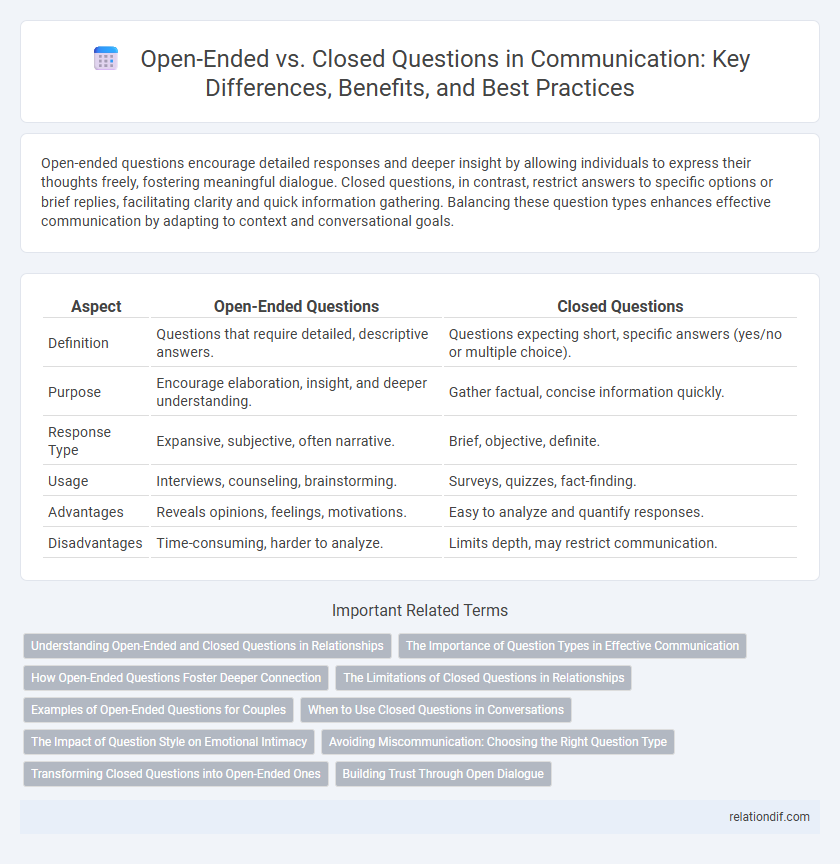Open-ended questions encourage detailed responses and deeper insight by allowing individuals to express their thoughts freely, fostering meaningful dialogue. Closed questions, in contrast, restrict answers to specific options or brief replies, facilitating clarity and quick information gathering. Balancing these question types enhances effective communication by adapting to context and conversational goals.
Table of Comparison
| Aspect | Open-Ended Questions | Closed Questions |
|---|---|---|
| Definition | Questions that require detailed, descriptive answers. | Questions expecting short, specific answers (yes/no or multiple choice). |
| Purpose | Encourage elaboration, insight, and deeper understanding. | Gather factual, concise information quickly. |
| Response Type | Expansive, subjective, often narrative. | Brief, objective, definite. |
| Usage | Interviews, counseling, brainstorming. | Surveys, quizzes, fact-finding. |
| Advantages | Reveals opinions, feelings, motivations. | Easy to analyze and quantify responses. |
| Disadvantages | Time-consuming, harder to analyze. | Limits depth, may restrict communication. |
Understanding Open-Ended and Closed Questions in Relationships
Open-ended questions encourage detailed responses and foster deeper understanding by allowing partners to express thoughts and feelings freely, enhancing emotional intimacy in relationships. Closed questions, which typically elicit yes/no or brief answers, can efficiently clarify specific information but may limit conversational depth. Balancing both question types helps partners navigate conversations effectively, promoting clarity and connection.
The Importance of Question Types in Effective Communication
Open-ended questions encourage detailed responses and promote deeper understanding, making them essential for effective communication. Closed questions yield concise, specific answers that help clarify facts quickly but limit elaboration. Mastering the balance between open-ended and closed questions enhances dialogue, improves information gathering, and fosters stronger interpersonal connections.
How Open-Ended Questions Foster Deeper Connection
Open-ended questions encourage expansive responses, enabling individuals to express feelings, thoughts, and experiences in greater depth, which strengthens emotional bonds. These questions stimulate meaningful dialogue by inviting elaboration and reflection, fostering trust and understanding in communication. Unlike closed questions that limit answers to yes/no or specific information, open-ended questions promote engagement and reveal underlying perspectives, essential for building deeper connections.
The Limitations of Closed Questions in Relationships
Closed questions restrict responses to limited options, often leading to superficial communication and hindered emotional connection in relationships. They can prevent partners from expressing deeper feelings or concerns, resulting in misunderstandings and unresolved conflicts. Relying heavily on closed questions diminishes opportunities for empathy and meaningful dialogue, essential for building trust and intimacy.
Examples of Open-Ended Questions for Couples
Open-ended questions for couples encourage deeper emotional connection and understanding, such as "How do you feel about our current communication?" or "What dreams do you have for our future together?" These questions invite detailed responses, fostering meaningful dialogue and empathy between partners. Using open-ended questions helps couples explore their thoughts and feelings beyond simple yes/no answers, strengthening their relationship.
When to Use Closed Questions in Conversations
Closed questions are most effective when seeking specific information or quick, concise answers in conversations. They streamline decision-making processes by limiting response options, making them ideal for surveys, interviews, or clarifications. Using closed questions enhances clarity and control in communication, especially in professional or time-sensitive contexts.
The Impact of Question Style on Emotional Intimacy
Open-ended questions foster emotional intimacy by encouraging detailed responses and self-expression, allowing individuals to share feelings and build deeper understanding. Closed questions typically limit answers to yes/no or brief replies, which can create emotional distance and hinder meaningful connection. Effective communication balances both styles, using open-ended questions to deepen relationships while employing closed questions for clarity and efficiency.
Avoiding Miscommunication: Choosing the Right Question Type
Open-ended questions encourage detailed responses and foster deeper understanding, which reduces the risk of miscommunication by allowing clarification and elaboration. Closed questions, offering specific, limited answers, are effective for obtaining clear, concise information but may restrict the flow of conversation and lead to assumptions. Selecting the appropriate question type based on context optimizes communication clarity and minimizes misunderstandings.
Transforming Closed Questions into Open-Ended Ones
Transforming closed questions into open-ended ones enhances communication by encouraging detailed responses and deeper insights. For example, changing "Did you complete the project?" to "What challenges did you encounter while completing the project?" invites elaboration and critical thinking. This technique promotes active listening and fosters meaningful dialogue in professional and personal interactions.
Building Trust Through Open Dialogue
Open-ended questions foster trust by encouraging detailed responses that reveal feelings and perspectives, creating a safe environment for open dialogue. Closed questions limit communication to brief answers, which may hinder relationship building and reduce understanding. Effective communication relies on open-ended inquiries to deepen connections and cultivate transparency.
Open-ended questions vs Closed questions Infographic

 relationdif.com
relationdif.com